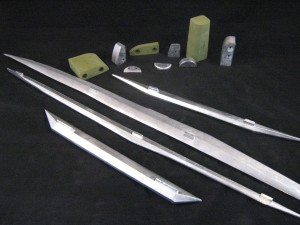 Many types of equipment require balancing or counterweights to allow the system work properly. Counterweights can be simple steel plates or they can be designed with complex geometrics because of the compartments in which they need to be placed. When you are designing a product that will require counterweights, there are many factors to consider.
Many types of equipment require balancing or counterweights to allow the system work properly. Counterweights can be simple steel plates or they can be designed with complex geometrics because of the compartments in which they need to be placed. When you are designing a product that will require counterweights, there are many factors to consider.
- How much counterweight will you need?
- How much space does the application have?
- Are there benefits to reducing the space or size of the counterweight?
- Are there benefits to adding more weight to the counterweight compartment?
- Is the counterweight going to be a freestanding part or will it be inside a compartment as one assembly?
- Will the counterweight(s) need to be removed or will there be trim balancing needed?
- What are the mechanical properties needed of the counterweight and what environment is it going into?
There are many options for counterweight designs in geometry and material. Steel is a good option; but in many cases it alone cannot attain the goals so other metals such as lead or tungsten must be used.
| Aluminum density | 2.7 g/cc |
| Steel density | 7.85 g/cc |
| Lead density | 11.34 g/cc (31% more dense than steel) |
| Tungsten density | 19.3 g/cc (59% more dense than steel, 41% more dense than lead) |
Lead
Lead is a good option that allows steel shells or other components to be filled since lead melts at a relatively low temperature. Lead can also be cast into shapes allowing it to be poured into a tool providing a lead weight that can be installed into a specific geometry. Lead costs more than steel but it carries a density that is roughly 31 percent more than steel. Lead counterweights can be painted or powder coated to cover the lead for handling purposes and the cost allows lead to be an excellent counterweight.
Tungsten
Tungsten is a sintered metal starting from raw APT powder. After sintering, tungsten is then machined to produce finished shapes. Tungsten is more expensive than lead, but it is 41 percent more dense than lead. Most applications that use tungsten counterweights are smaller with very specific geometries. This makes it ideal for small compartments or in applications where greater mechanical properties are needed over lead.
Some counterweight applications include:
- Medical equipment
- Bridge counterweights
- Aerospace
- Rotating products
- Industrial applications
- Fork Trucks & Lifts
- Bridge Weights
- Elevator Weights
- Sonar Weights
Metal Densities
| Material | kg/m^3 |
| Antimony | 6,690 |
| Zinc | 7,000 |
| Chromium | 7,200 |
| Tin | 7,310 |
| Manganese | 7,325 |
| Iron | 7,870 |
| Niobium | 8,570 |
| Brass | 8,600 |
| Cadmium | 8,650 |
| Cobalt | 8,900 |
| Nickel | 8,900 |
| Copper | 8,940 |
| Bismuth | 9,750 |
| Molybdenum | 10,220 |
| Silver | 10,500 |
| Lead | 11,340 |
| Thorium | 11,700 |
| Rhodium | 12,410 |
| Mercury | 13,546 |
| Tantalum | 16,600 |
| Uranium | 18,800 |
| Tungsten | 19,300 |
| Gold | 19,320 |
| Plutonium | 19,840 |
| Platinum | 21,450 |
| Iridium | 22,420 |
| Osmium | 22,570 |
Please contact us for any of your counterweight needs.

